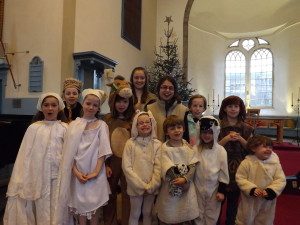Plum is telling stories. Arms thrown wide, shiny eyes looking to see who will hear and with a loud voice, he calls out.
House! Castle! Windows! Birds! Flying! Helicopter! Bus!
He’s all about single words right now and gives us long lists. But they aren’t just lists; they are stories. Each word builds on the last into a deliberate narrative. And these stories are mainly about the things that he’s seen and that surround him. Well, not quite for the castle bit. That might need some explaining. Yes, there is a castle not too far from where we live, but the castle he means is really just our neighbourhood. We live in a tenement flat (which isn’t as squalid as it sounds) – square blocks of tall row houses all more or less the same with mirroring windows and doors. The neighbourhood was built in the 1880s when Scottish Baronial was the style du jour, so there are crows-stepped roofs, faux crests, flamboyant carve initials and even a stone canon in the next block.
It’s all meant to be very impressive, and as we walk down street on the way to the primary school to pick up the bigger kids, my little one points and cries out Castle!
When Beangirl was at this stage, she thought Ottawa’s big apartment buildings were ships. Funny the confusion that architecture can create. But maybe not just for kids.
Architectural name-calling comes into the lectionary today. It’s the passage about the money lenders in the temple, about Jesus’ rage.
Stop making my Father’s House a marketplace!” His disciples remembered that it was written, “Zeal for your house will consume me.”
The walls of the temple were designed to impress, of course, but also to create a different kind of space. You would look at those walls and see something out of the ordinary – a place set aside. And when you entered, you would find a space where God felt closer, where human actions and divine intentions might intersect. But then human intentions got in the way. If the Temple was to be a place of sacrifice, then there was a need to supply sacrifices to those who might show up empty handed. So the outer gentile courtyards were set up as a market place. But then there was also a worry about using gentile money – with its graven images – in the temple. So money changers set up shop, converting pilgrims’ coins into temple money. And making a tidy profit on the side. The temple became a walled market rather than a sacred space.
Walls can be tricky things. Walls in Jerusalem. Walls in Belfast. The walls of our houses, our neighbourhoods, our churches. The walls we imagine, keeping us in. Or out. Together. Or separate. Proper. Safe.
The church where we worship as a family is a light open space. The windows are clear, the ceiling is very high and white and so are the pillars and walls. The pews themselves are a beautiful incongruous blue which removes any sense of austerity from the sanctuary. It is a lovely room.
It was built in 1691 and was considered then to look rather Dutch. It was still uncertain then whether the Reformation would stick so the cruciform style was seemed to be adaptable if the religious accepted religious traditions shifted. Later Presbyterian generations added balconies that changed the soaring open feeling of the sanctuary. The chancel itself was blocked off and turned into a meeting room. (Yes.) A large pulpit was placed front and centre in the now-shortened sanctuary, and high on the wall above, confronting the congregation face on, hung two large leather boards bearing the 10 commandments. It became a very different kind of worship environment. Teaching and obedience quite literally took centre stage. There are good intentions here.
You can see that. But years went by these new renovations must have felt old. The church looked dark and closed. The neighbourhood itself was going through a time of grim decline, so it’s no wonder that there wasn’t much money to keep things shiny and bright.
Then about 60 years ago, the congregation again undertook renovation and that wall at the front of the sanctuary came down, opening up the chancel space again. The commandments were moved onto the side walls in the chancel – still there, but not so dominant. A communion table was placed in the centre and the pulpit was moved to one side. The large central window was made visible again. This window is beautiful. Two tall rounded arches made of clear glass topped with a central heart-shaped window. Without the wall, light flooded into the sanctuary, and the worshipping congregation would point their faces towards the light. 
It doesn’t feel a large step from tearing down walls to turning over tables and, while I’m fairly sure that the church renovators were thinking more about design and beauty, there’s something in their story that sheds light on the gospel story. When Jesus threw over the tables, he was overturning darkened religious traditions and letting in God’ light. He cleared away human practicality which had turned into an instrument for human oppression. The traders’ tables had turned the actions of sacrifice into yet another location for human greed. The Temple’s sacred space was broken by human greed. Which made it a strong and strong symbol of the very body of Jesus broken for humanity’s breaking hearts.
Broken and remade so that the rest of us might also be remade. Remade and reborn in light. Christ told us a new story about the things around us, and about the love that surrounds us. He broke down the walls and let light flood in.



